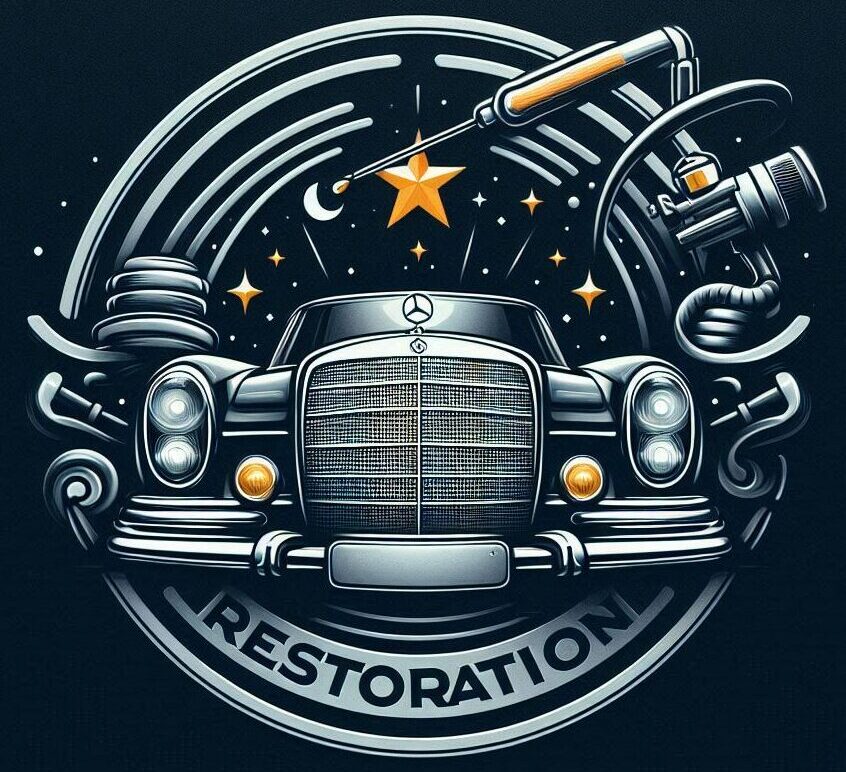
Restoring a classic car is an enriching journey. It’s not just about making a car look beautiful again—it’s about breathing life into a piece of history. But taking on a restoration project can feel overwhelming, especially if you’re unsure where to start. Let’s dive in understanding the Restoration Process: Step-by-Step Guide
Restoration is all about bringing something back to its original glory or function. Think of repairing an old piece of furniture or revamping a historic building. It’s about figuring out what needs fixing and then getting it done in the best way possible.
This guide will walk you through the restoration process step-by-step, from planning to finishing touches. Whether you’re restoring a vintage Mercedes or another classic, these steps will help you stay organized and make the most of your project.
Step 1: Set Your Goals and Create a Plan
Why It Matters: A clear plan helps you stay on track, avoid costly mistakes, and set realistic expectations.
What to Do: Decide what type of restoration you want. Are you aiming for a full restoration (returning the car to factory-new condition) or a partial restoration (preserving some of its aged character)? Write down a list of tasks you’ll need to complete and estimate the time and cost for each.
Resources:
- Planning Tips: Classic Car Restoration Club offers project planning resources.
- Restoration Guides: Check Hemmings for inspiration and examples of full vs. partial restorations.
Step 2: Assess the Car’s Condition
Why It Matters: Knowing the car’s condition from the start helps you set a realistic budget and timeline.
What to Do: Do a detailed inspection of the car’s body, engine, and interior. Take note of any rust, damage, or worn parts. Identify what’s missing, broken, or in need of a refresh. If you’re not comfortable with this step, consider having a mechanic perform an inspection to get a professional opinion.
Resources:
- Inspection Checklist: Schumacher Logistics offers a checklist for assesing classic cars.
- Local Mechanic Directory: Find qualified mechanics on Yelp.
Step 3: Set a Realistic Budget
Why It Matters: Restoration costs can add up quickly, so setting a budget helps you manage your spending and avoid surprises.
What to Do: Break down your budget by category—bodywork, paint, engine parts, interior, and tools. Add a buffer of about 10–20% for unexpected costs, which are common in restoration projects. Remember to factor in professional labor if you’re hiring help.
Resources:
- Budget Calculator: Classic Car Restoration Club’s Budget Guide can help you estimate costs.
- Parts Pricing: Check RockAuto for parts and pricing, and eBay Motors for used or hard-to-find items.
Step 4: Disassemble the Car and Document Each Step
Why It Matters: Taking the car apart is necessary, but documenting each step helps you reassemble it correctly later.
What to Do: Start by carefully removing each component, keeping bolts, nuts, and small parts organized in labeled containers. Take plenty of photos as you go and consider writing notes or even making a video of each step for future reference. This documentation will be a lifesaver during reassembly.
Resources:
- Organization Tips: Family Handyman offers simple ways to keep parts organized.
- Storage Supplies: Look for affordable storage containers at Harbor Freight.
Step 5: Address Rust and Bodywork
Why It Matters: Rust can weaken the structure of the car and diminish its value, so addressing it early is crucial.
What to Do: Remove rust from metal parts with a wire brush or chemical rust remover, then apply a rust-preventative coating. For body panels, use welding techniques to repair any rust holes. If bodywork isn’t your expertise, this is one area where professional help can make a big difference.
Resources:
- Rust Removal Guide: Eastwood has rust treatment products and tutorials.
- Body Shop Locator: Find local body shops on Google Maps and read reviews.
Step 6: Restore or Rebuild the Engine
Why It Matters: The engine is the heart of the car, and a well-running engine will make your restoration far more satisfying.
What to Do: Disassemble the engine and inspect each component—pistons, crankshaft, valves, and bearings. Clean or replace parts as necessary. If you’re not experienced with engine rebuilding, consider taking it to a mechanic specialising in classic engines.
Resources:
- Engine Rebuild Kits: Summit Racing offers rebuild kits for classic car engines.
- Mechanic Search: Use Yelp to find classic car mechanics near you.
Step 7: Restore or Replace the Interior
Why It Matters: The interior is where you’ll spend time enjoying the car, so getting it right is essential for a complete restoration.
What to Do: Start by removing old upholstery, carpets, and any damaged trim. Decide whether you want to restore the original materials or upgrade to new ones. Upholstery kits for classic cars are often available, making it easier to get a factory look. Clean or replace the dashboard, steering wheel, and gauges as needed.
Resources:
- Interior Kits: Automotive Interiors sells upholstery kits for classic cars.
- DIY Upholstery Guide: Classic Car Restoration Club offers tutorials for interior work.
Step 8: Handle the Electrical System
Why It Matters: The electrical system is crucial for everything from starting the car to operating lights and gauges.
What to Do: Inspect the wiring for any frays, rust, or other damage. Replace damaged wires and consider upgrading old systems (like the alternator or battery) if you’re looking for reliability. Classic car wiring diagrams are helpful, especially if you’re doing this yourself. If you’re unsure, consult an auto electrician.
Resources:
- Wiring Diagrams: AutoZone has wiring diagrams for many models.
- Professional Help: Locate auto electricians on Yelp.
Step 9: Prepare and Paint the Exterior
Why It Matters: A fresh coat of paint not only enhances appearance but also adds value and protects the body from future rust.
What to Do: Sand down the old paint and apply a primer to prepare the surface. If you’re new to painting, practice on a smaller area first, as paint requires skill for even application. Consider hiring a professional for the final coat, especially for rare or high-value models, to achieve a showroom-quality finish.
Resources:
- Painting Tips: Eastwood provides tools and guides on auto painting.
- Find a Paint Shop: Use Google Maps to locate and read reviews on local auto paint shops.
Step 10: Reassemble and Test Everything
Why It Matters: Reassembly is where all your hard work comes together, and careful attention here will ensure everything functions as it should.
What to Do: Using your documentation from the disassembly phase, start putting everything back together in the reverse order. Connect each part carefully, checking for proper fit and tightness. Once everything is reassembled, run tests on the engine, brakes, and electrical systems. Take the car for a short drive to identify any issues before putting it back on the road fully.
Resources:
- Troubleshooting Tips: Hemmings has troubleshooting guides that are helpful during testing.
- Testing Equipment: Check Harbor Freight for affordable testing tools like multimeters and compression testers.
Step 11: Final Details and Finishing Touches
Why It Matters: Finishing touches, like badges, trim, and detailing, add polish and make your restoration feel complete.
What to Do: Install any decorative elements, like emblems and badges. Clean the car thoroughly, inside and out, to showcase your hard work. Consider ceramic coating or waxing the exterior for extra shine and protection.
Resources:
- Detailing Supplies: Meguiar’s offers high-quality detailing products for classic cars.
- Badge and Trim Sourcing: Find vintage emblems on eBay Motors or Mercedes-Benz Classic Center.
Wrapping Up Understanding The Restoration Process: Step-by-Step Guide
Restoring a classic car is a labor of love that takes time, effort, and attention to detail. By following this step-by-step guide, you can transform your classic car into a beautifully restored piece of history.

This article provides a fantastic, step-by-step breakdown of the car restoration process, from initial planning to final assembly. The importance of documenting disassembly really stood out—such a lifesaver during reassembly! I also appreciate the guidance on budget management and rust removal. Do you find certain restoration steps are more challenging for first-time restorers? Thanks for making this complex process easy for a newbie like me!
Thank you for the kind words! I’m so glad you found the breakdown helpful. The most challenging steps for first-time restorers can often be bodywork, like rust removal and panel alignment, as they require a careful touch and patience. Electrical work can also be tricky, especially if the wiring is outdated or needs to be entirely replaced. Also, It requires expertise to replace the system. Budget management is another big one. Don’t hesitate to ask any other questions, and good luck with your restoration journey!